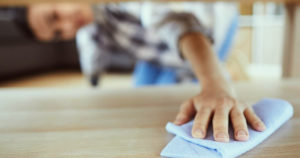Dust mites may be the most common trigger of year-round allergies and asthma. Dust mites are literally everywhere, no matter your climate, country or continent.
 Even though dust mites are invisible, they are far from harmless. They live on human skin cells, fabric items, bedding, upholstery, clothing and carpets. An interesting fact is that dust mites are not the reason for allergies. Most often their droppings are responsible for any allergic reactions. They produce a lot of droppings ( each dust mite produces around 20 a day), so no matter how much you clean, you will still havesome mite irritants at home. Even though you won’t be able to completely rid your house of those creatures, you can significantly reduce your allergic reactions to them.
Even though dust mites are invisible, they are far from harmless. They live on human skin cells, fabric items, bedding, upholstery, clothing and carpets. An interesting fact is that dust mites are not the reason for allergies. Most often their droppings are responsible for any allergic reactions. They produce a lot of droppings ( each dust mite produces around 20 a day), so no matter how much you clean, you will still havesome mite irritants at home. Even though you won’t be able to completely rid your house of those creatures, you can significantly reduce your allergic reactions to them.
In this article we will discuss some common allergy symptoms you should look out for, share some dusting tips and tell you how to reduce dust mites in the different areas of your house in the most efficient way.
If you suffer from a dust mite allergy you might experience the following symptoms:
- Watery eyes
- Itching
- Loss of smell
- Runny nose
- Stuffy nose
- Sneezing
- Coughing
- Tightness in chest
If you have one or more of those, or you suspect that you or someone in your family might be suffering from a dust mite allergy, go to a doctor. There are skin prick tests that will place an allergen on the patient’s skin and cause inflammation if an allergy is present.
Let’s look at the most common places for dust mites around your house.
Bed
Just think about all the time that you spent in your bed tossing and turning. You shed enough skin cells to feed an army of dust mites. What is more, the fabric of your bed linen, the warmth and the large amounts of food make it a paradise for mites. Here is how you can reduce the dust mite activity in your bed:
- Wash your bedding regularly at 60° at least once a week.
- When changing your sheets, always vacuum your mattress.
- Invest in an anti-allergy bedding protector ( mattress protector)
- Air your bed every morning. Pull your covers back, open your windows and let it air out for a bit.
- Dust and vacuum your bedroom on a regular basis
- Wash your duvets and pillows once every few months
Carpets
If you have a dust mite allergy, you may want to switch to laminate, hardwood or tile flooring. It still contains dust mites but compared to carpets, their amount is significantly smaller. What is more, removing dust mites from hard floors is much easier than removing them from carpets.
The best way to rid your carpets of dust mites is regular vacuuming ( preferably with a HEPA filter vacuum cleaner). Steam cleaners are also rather efficient against mites, thanks to the high temperature they reach. Make sure to vacuum your carpets at least once a week. Vacuum your upholstery as well, including behind and under furniture, as well as between couch pillows. Get all your carpets and upholstery professionally steam cleaned every few months. Usually once a year is enough but if you suffer from allergies, you might want to do it more often.
Curtains
Curtains are a place in your home that attracts and collects a lot of dust mites. They are not only made of fabric, but also hang right by your window where dust passes from the outside to the inside. Heavier curtains are prone to collecting a lot more dust mites than lighter ones so you may want to either switch to thinner curtains or blinds.
If you have heavy textile curtains, make sure to wash them in hot water once every few months.
pro tip: Steam clean your curtains along with your upholstery and carpets.
When Dusting
Make sure you don’t use a dry cloth when dusting. That will only spread more dust around your place. Use a damp microfiber cloth to collect most of the dust – it will hold onto dirt and dust more effectively.
Do not forget to dust on top of furniture, cupboards, doors and picture frames. Always include the thorough dusting of your whole house in your regular cleaning schedule.
pro tip: Use dryer sheets when dusting furniture. They will not only collect all the dust, but also leave a layer of residue that will prevent dust from settling in the future.
If you are in fact allergic to dust mites, make sure to protect yourself when cleaning and especially dusting. If you are particularly sensitive to dust and dust mites, wearing a mask over your mouth and nose will help you reduce irritations caused by dust and allergens flying around in the air.
